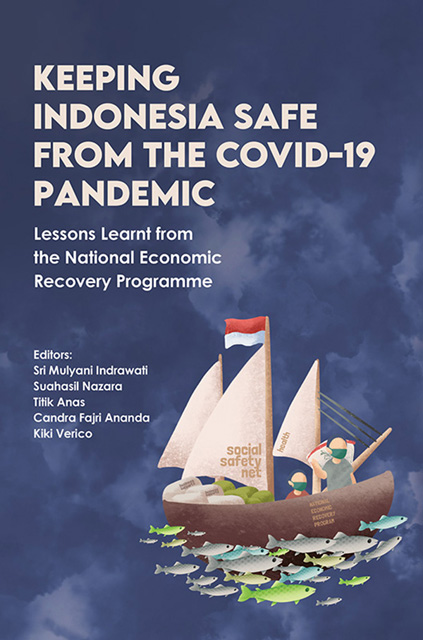 Keeping Indonesia Safe from the COVID-19 Pandemic
Keeping Indonesia Safe from the COVID-19 Pandemic Book contents
- Frontmatter
- Contents
- List of Figures
- List of Tables
- List of Boxes, Annexes and Appendixes
- Acknowledgements
- Glossary
- The Contributors
- Foreword: Keeping Indonesia Safe from the COVID-19 Pandemic Lessons Learnt from the National Economic Recovery Programme
- Part I Health Shock
- Part II Economic Shock: The Framework
- Part III Revenue Shock And Response
- Part IV Expenditure Side (Human Capital)
- Part V Expenditure Side (Msmes And Corporate Sector)
- Part VI Regional Dynamics
- Part VII New Ways Of Working
- Index
8 - Protecting the People
Published online by Cambridge University Press: 30 June 2023
- Frontmatter
- Contents
- List of Figures
- List of Tables
- List of Boxes, Annexes and Appendixes
- Acknowledgements
- Glossary
- The Contributors
- Foreword: Keeping Indonesia Safe from the COVID-19 Pandemic Lessons Learnt from the National Economic Recovery Programme
- Part I Health Shock
- Part II Economic Shock: The Framework
- Part III Revenue Shock And Response
- Part IV Expenditure Side (Human Capital)
- Part V Expenditure Side (Msmes And Corporate Sector)
- Part VI Regional Dynamics
- Part VII New Ways Of Working
- Index
Summary
BACKGROUND
At the end of 2019, the world was stunned by the emergence of an alarming new virus. After numerous failed attempts to contain it, by March 2020 the World Health Organization finally recognized COVID-19 as a pandemic. The rapid spread of the virus gave little time for governments all over the world to brace for its impact. While some governments bought time by implementing travel restrictions, the Indonesian government, fearing an economic slowdown, initially played down the virus’ threat by running a travel campaign in February 2020. However, as the COVID-19 death toll crept up, by March it was clear that the virus was a real threat. By April 2020 when the virus has spread to all of Indonesia's thirty-four provinces, the government finally implemented social restrictions in the Greater Jakarta area.
As people reduced their mobility, the economy slowed, and many breadwinners lost their income. Amidst such a condition, an increase in the poverty rate was expected. Although initially the poverty rate projections forecast that Indonesia's years of poverty alleviation efforts may be reversed as people fell into poverty, the country did better than expected. The poverty rate was projected to be as high as 13.38 per cent (World Bank 2020a). The actual outcome, however, defied many of these projections.
Considering that Indonesia experienced a significant economic contraction of up to –5.32 per cent in the second quarter of 2020, it was remarkable how Indonesia's poverty rate only climbed up to 9.78 per cent in March 2020 from its low of 9.22 per cent before the pandemic. This figure would then peak at 10.19 per cent in September 2020 (Statistics Indonesia 2020). By September 2021, Indonesia has returned to a singledigit poverty rate, which equated to 1.04 million people moving out of poverty (Statistics Indonesia 2022). International institutions, such as the World Bank, attributed the Indonesian government's success in keeping the country's poverty rate down to the many social assistance and social safety net programmes deployed throughout the pandemic.
When the pandemic struck, Indonesia was in a better position than in 1998 when the Asian Financial Crisis shook its economy. Before the COVID-19 pandemic, Indonesia already had a running social protection system.
- Type
- Chapter
- Information
- Keeping Indonesia Safe from the COVID-19 PandemicLessons Learnt from the National Economic Recovery Programme, pp. 257 - 290Publisher: ISEAS–Yusof Ishak InstitutePrint publication year: 2022


